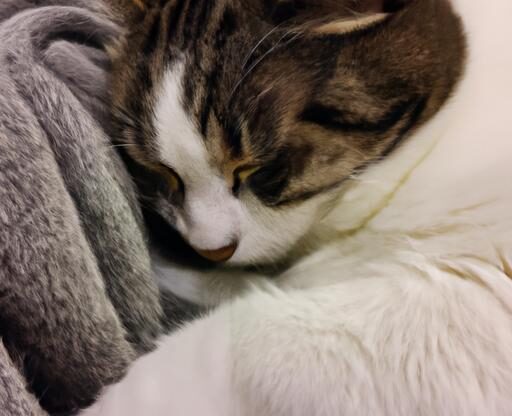Cat Behaviour After Sedation: What to Expect and Why It Matters
Introduction
If you’ve ever had to sedate your beloved feline friend, you know how important it is to ensure their safety and well-being during the process. Cat sedation serves a vital purpose, whether it’s for a medical procedure, grooming, or travel. However, it’s crucial to understand how sedation can affect your cat’s behavior afterward.
The Purpose of Cat Sedation
Cat sedation is commonly used to alleviate anxiety and facilitate various procedures that may cause stress for our feline companions. Whether it’s a dental cleaning, surgery, or even a grooming session, sedation helps keep our kitties calm and comfortable. By inducing a relaxed state, it allows veterinarians to perform their tasks efficiently while minimizing any potential distress to our furry friends.
Understanding Post-Sedation Behavior
After the sedation wears off, you might notice some changes in your cat’s behavior. It’s essential to be aware of these behavioral shifts to ensure your cat’s well-being and provide them with the necessary care during their recovery period. While every cat is unique and may respond differently to sedation, there are some common behaviors you can expect.
Some cats might appear groggy or disoriented, experiencing a temporary lack of coordination. Others might be more subdued, preferring to retreat to a quiet and familiar space. You may also notice changes in appetite, thirst, or litter box habits. These behaviors are typically transient and should resolve as your cat fully recovers from the sedation.
Why Understanding Cat Behavior After Sedation Matters
Understanding your cat’s behavior after sedation is crucial for several reasons. Firstly, it allows you to monitor their progress and ensure they are recovering as expected. By being aware of any unusual behaviors or prolonged effects, you can promptly seek veterinary assistance if necessary.
Moreover, recognizing and addressing any behavior changes can help ease your cat’s anxiety and make their recovery more comfortable. By providing a calm and supportive environment, you can help them regain their confidence and return to their usual routines more quickly.
Stay tuned for the next section, where we will delve deeper into the different sedation methods used for cats and the potential side effects they may have. Let’s ensure your feline friend has a smooth and stress-free recovery post-sedation!
Understanding Cat Sedation
Different Sedation Methods for Cats
When it comes to sedating cats, veterinarians utilize various methods tailored to each individual cat’s needs. These methods ensure the safety and comfort of our furry companions during medical procedures or other stressful situations.
1. Oral Sedation: This method involves administering sedative medications in the form of pills or liquid. It is commonly used for mild sedation, such as for grooming appointments or less invasive procedures. Oral sedation allows for ease of administration and a smoother recovery period.
2. Injectable Sedation: For more complex procedures or when a deeper level of sedation is required, veterinarians often opt for injectable sedatives. These medications are administered directly into the cat’s bloodstream, inducing a more profound sedative effect. Injectable sedation provides a higher level of control and allows for adjustments in dosage during the procedure, ensuring the cat’s safety and comfort.
3. Inhalant Sedation: In certain cases, inhalant sedation may be utilized, typically in combination with injectable sedatives. This method involves using anesthetic gases that are inhaled by the cat through a mask or tube. Inhalant sedation allows for precise control of the sedative effect and is commonly used for more invasive procedures such as surgeries.
Potential Side Effects and Risks
While sedation is generally safe for cats, it’s essential to be aware of potential side effects and risks associated with this process. These can vary depending on the sedation method used, the cat’s individual response, and the specific procedure being performed.
1. Grogginess and Disorientation: It is common for cats to experience grogginess or disorientation immediately after sedation. This can manifest as temporary unsteady movements, confusion, or a dazed appearance. It’s important to provide a calm and secure environment during this time to prevent any accidents or injuries.
2. Altered Appetite and Thirst: Sedation can temporarily affect a cat’s appetite and thirst. Some cats may experience a decrease in appetite or thirst due to the sedative’s effects. It’s crucial to monitor their intake and ensure they stay hydrated during the recovery period.
3. Allergic Reactions: While rare, some cats may exhibit allergic reactions to sedative medications. These reactions can range from mild to severe and may include symptoms such as itching, swelling, or difficulty breathing. If you notice any signs of an allergic reaction, seek immediate veterinary assistance.
4. Prolonged Recovery: Occasionally, cats may take longer to fully recover from sedation, especially if they have underlying health conditions or are older. It’s important to monitor their behavior closely and consult with your veterinarian if you have any concerns or notice any prolonged effects.
Understanding the different sedation methods and potential side effects allows us to make informed decisions for our cats’ well-being. In the next section, we will explore the immediate post-sedation behavior of cats and how to create a calm and safe environment to aid their recovery. Let’s ensure your furry friend has a smooth and comfortable journey towards normalcy!
Immediate Post-Sedation Behavior
After sedation, your furry companion may display various behaviors that are typical during the immediate recovery phase. Understanding these behaviors will help you support your cat’s well-being during this crucial time.
Common Behaviors after Sedation
It’s not uncommon for cats to exhibit grogginess or disorientation immediately after sedation. They may have difficulty walking or balancing, appearing a bit wobbly on their feet. Some cats might be more vocal or display signs of confusion. Remember, these behaviors are temporary and should gradually improve as the sedation effects wear off.
Physical and Mental Effects of Sedation
Sedation can have both physical and mental effects on your feline friend. Physically, your cat might experience a decrease in heart rate and blood pressure, which can contribute to the initial sluggishness or lethargy. Mentally, they may feel drowsy or less responsive to their surroundings. It’s essential to provide a comfortable and quiet space where they can rest and recover undisturbed.
Tips for a Calm and Safe Environment
Creating a calm and safe environment is crucial for your cat’s immediate post-sedation recovery. Here are some tips to help you provide the best care:
-
Quiet and Familiar Space: Prepare a secluded area in your home where your cat can relax and feel secure. Ensure it’s free from loud noises, other pets, or young children that may cause additional stress.
-
Soft Bedding: Offer a cozy bed or blanket where your cat can recuperate comfortably. Familiar scents can help provide a sense of security.
-
Proper Temperature: Maintain a warm and comfortable room temperature, as sedation can cause a temporary drop in body temperature. Avoid exposing your cat to drafts or extreme heat.
-
Monitoring Food and Water: Offer small amounts of water and easily digestible food, such as wet cat food, to prevent dehydration and support their recovery. However, avoid overfeeding and consult your veterinarian for specific dietary recommendations.
-
Minimize Stressors: Limit interactions with other pets or family members, as well as loud noises or sudden movements, to reduce stress during this sensitive period.
By following these tips, you can create a peaceful environment that promotes your cat’s healing and minimizes any potential post-sedation discomfort.
Stay tuned for the next section, where we will explore the typical recovery time for cats after sedation and discuss how to monitor and assist them during this phase. Together, we’ll ensure a smooth and speedy recovery for your beloved feline companion.
Typical Recovery Time
Sedation affects each cat differently, and the duration of post-sedation behavior changes can vary based on several factors. It’s important to understand these factors to have realistic expectations regarding your cat’s recovery. Let’s explore the key influences on recovery time and how you can monitor and assist your feline friend during this period.
Factors Influencing Recovery Duration
-
Type and Dosage of Sedation: Different sedation methods and dosages can have varying effects on cats. Some sedatives may have a shorter duration of action, leading to a quicker recovery, while others may take longer to wear off.
-
Cat’s Age and Health: Older cats or those with underlying health conditions may take longer to recover from sedation. Their bodies may require more time to metabolize the sedatives and regain their normal state.
-
Procedure Complexity: The type of procedure your cat underwent can also impact their recovery time. More invasive or lengthy procedures may result in a longer recovery period as the body needs time to heal and adjust.
Average Recovery Time
While recovery time can differ for each cat, a general guideline can help you estimate how long it may take for your feline friend to bounce back after sedation. On average, most cats recover fully within 12 to 24 hours following sedation. However, it’s essential to remember that individual variations exist, and some cats may take longer to return to their usual selves.
Monitoring and Assisting Your Cat
During the recovery period, it’s crucial to monitor your cat’s behavior and provide appropriate care to aid their healing process. Here are some tips to help you along the way:
-
Observe Behavior: Keep a close eye on your cat for any unusual or prolonged changes in behavior. If you notice anything concerning, such as extreme lethargy or disorientation, consult your veterinarian promptly.
-
Create a Calm Environment: Provide a quiet and comfortable space for your cat to rest and recover. Minimize noise, traffic, and other stressors that could hinder their recovery process.
-
Offer Supportive Care: Ensure your cat has access to fresh water, a clean litter box, and a soft bed. Encourage gentle movement and provide a balanced diet to aid their overall well-being.
By understanding the factors influencing recovery time and providing the necessary support, you can help your cat navigate the post-sedation period smoothly. Stay tuned for the next section, where we will discuss unusual behavior after sedation and when to seek veterinary assistance.
Unusual Behavior After Sedation
After sedation, it’s not uncommon for cats to exhibit some unusual behaviors. While most of these behaviors are temporary and resolve on their own, it’s essential to be aware of any concerning signs. Here are some key points to help you navigate through your cat’s post-sedation behavior:
Identifying Uncommon Behaviors
While each cat may react differently to sedation, some behaviors may be considered out of the ordinary. Keep an eye out for signs such as prolonged lethargy or excessive restlessness, persistent disorientation, or difficulty walking. Aggressive behavior, excessive vocalization, or refusal to eat or drink are also worth noting. Any behavior that seems abnormal or causes you concern should be carefully observed.
Possible Causes for Abnormal Behavior
Various factors can contribute to abnormal behavior after sedation. Sedative medications can affect cats differently, and individual sensitivity can play a role. Some cats may experience an adverse reaction or have difficulty metabolizing the sedative, leading to prolonged or atypical behavior changes. Pre-existing health conditions, pain, or discomfort from the procedure itself can also influence behavior. Stress and anxiety related to the sedation process can further contribute to unusual behaviors.
Seeking Veterinary Assistance
If you notice any unusual or concerning behavior in your cat after sedation, it’s crucial to consult your veterinarian promptly. They are the best resource to evaluate your cat’s specific situation and provide appropriate guidance. Your veterinarian can help determine whether the behavior is a normal part of the recovery process or if further evaluation and intervention are necessary. Don’t hesitate to reach out to them for professional advice and support.
Remember, as a cat parent, you know your furry companion best. Trust your instincts and observe any changes in behavior carefully. By staying vigilant and seeking veterinary assistance when needed, you can ensure your cat’s well-being and provide them with the necessary care during their recovery.
Conclusion
In conclusion, understanding your cat’s behavior after sedation is vital for their well-being and your peace of mind. By comprehending the purpose of sedation and how it can temporarily affect your feline companion, you can provide the necessary care and support during their recovery.
Throughout this article, we explored the various aspects of cat sedation and its impact on behavior. We discussed the common behaviors observed immediately after sedation, the typical recovery time, and the potential long-term effects. By being aware of these factors, you can ensure a smooth transition for your cat back to their normal routines.
Remember, each cat is unique, and their response to sedation may vary. Some cats may bounce back quickly, while others may take a bit longer to fully recover. Patience and understanding are key in helping your feline friend through this process.
If you notice any unusual or concerning behaviors that persist beyond the expected recovery period, it’s crucial to seek veterinary assistance. They can provide guidance, evaluate your cat’s condition, and address any underlying issues that may be contributing to the behavior changes.
Ultimately, by being attentive to your cat’s behavior after sedation and providing a nurturing environment, you can ensure their comfort, safety, and overall well-being. Your furry friend will thank you for your care and attention as they navigate their way back to their happy and healthy selves.
Thank you for joining me on this journey of understanding cat behavior after sedation. Wishing you and your feline companion a harmonious and stress-free recovery process!





